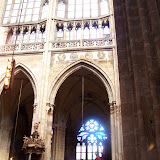
They say that
fairer than the golden strands of steaming hair
that encircles Apollo's crown.
The streets were vacant when I came;
deserted when I left.
Through the cool shadows of the morning, I walked
to the rising warmth of dusk.
I wandered through
the town's deserted streets
from castle ridge
to local vitner and back,
around the empty lanes
where Jan of Drazic once rode
and John Augusta raised his voice
to protest Catholic avarice and vice.
I stood before the windows where Tycho Brahe gazed
and spanned the universe with measurements,
between the earth and backward roaming Mars
that conjoins with Saturn every twenty years
to create chaos on the earth.
Where Tycho left a record of a solar eclipse
so many centuries ago on June sixth.
I left the vineyards sleeping by the castle
to follow the wayward road
that led beyond a lazy wooded hill
into an tangled path.
It led me down through
meadow lands,
across a narrow rumbling bridge,
and through waves of newly scalloped fields
where workers fought with enormous snakes of irrigation pipes.
Dust clouds rose from the padded
footprints in the sand;
time stretched its legs behind me.
Each step was yet another,
kilometer and kilometer together,
there'd be no turning back.
I saw the noble falcons circling
in the sky,
awaiting a rabbit to go bounding by.
The onion-pickers bent double by their toil,
did not unbend or wave at me
as I passed them by.
And still the way lay long before me
as day stretched loong behind me,
I passed, a shadow, through villages alone.
The road wound round deserted churches
and forgotten baroque saints,
created for the counter-reformation
and persecution of Bohemian Brethern
that inhabited this land.
Though Thirty Years of war were fought
and even more endured,
the land lies peaceful in this evening
that echoes with the shot
of a solitary huntsman shooting wily pheasants.
From meridian to eve I kept
my pace,
and feared I might miss the train
and sore pressed, I never once looked back
to where I once had stood
before your house.
There was no other way
when I had stepped upon the path,
for way leads onto way
and path breaks into path
as I made the lengthy trek
from Benatky to Lysa on the
Unless I put your home behind me,
there is no way to
They say that
but fairer is Benatky
that hides the secrets of your eyes
and the shadows of your smile.
And there, the birds all practice lively trills
to contest your fingers' lively arpeggios
and even lowly chickens got Gershwinn's rhythm
in cackling enthusiastic syncopation.
The sunlight flirts with shadows on the Jezera
with kisses rippled by the wind
that reminds me of your gentle laughter
mixed with the charm of Mozart arias
inside the Lichtenstein Palais.
Somewhere in evening's shade,
a listener hears a snatch of Brahms Ballade,
the rippling charm of Chopin's nocturnes
and Debussy's moonlight's enchantment
spun with the spinner's gossamer thread
that snares the gleaming raindrop
to glisten in the morning sun.
They say that
but fairer are your hands
that draws the winsome music from the keys
and weaves its net around me.

















































